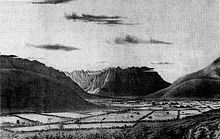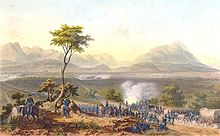Battle of Monterrey
| date | September 21 to 24, 1846 |
|---|---|
| location | near Monterrey , Mexico |
| exit | American victory |
| Parties to the conflict | |
|---|---|
| Commander | |
| Troop strength | |
| 6.220 | 7,303 42 guns |
| losses | |
|
488 dead and wounded |
367 dead and wounded |
The Battle of Monterrey was a battle of the Mexican-American War in which Mexican and American troops clashed in and around Monterrey from September 21 to 24, 1846 . The Mexicans managed to briefly stop the US troops at the fortress of Monterrey.
prehistory
After several defeats, the Mexican Northern Army was ordered by Santa Anna to retreat to Saltillo to take up defensive positions there. Their commander, General Pedro de Ampudia , ignored the order and decided to join the forces of Zachary Taylor at Monterrey with 7,303 men and 42 cannons . The reasons for this were the dissatisfaction of his troops with the constant retreats and changes in command, as well as Ampudia's desire to achieve a victory. Pioneers built forts and fortifications in and around the city to strengthen its defenses. Ampudia's plan to confront Taylor at Marín in order to take advantage of his superiority in cavalry on the favorable terrain and to be able to retreat to the defensive positions in Monterrey in the event of a defeat, failed because some brigade commanders did not consider their units to be ready for combat. The plans and preparations for the defense were confused and undecided, the relationship between Ampudia and his commanders disturbed. These circumstances had a negative effect on the morale of the troops.
Meanwhile, Taylor's troops marched from Camargo at the end of August . On September 19 at 9 a.m. he reached Monterrey with 6,640 men and immediately came under artillery fire. Taylor moved into a camp in the Santo Domingo forest in front of the city and sent out reconnaissance troops.
The course of the battle
Monterrey had 10,000 inhabitants and was heavily fortified. The Rio Santa Catarina runs south of the city and the foothills of the Sierra Madre Oriental rise to the south and west . Between them run the Santa Catarina and the Saltillo road, which was Monterrey's only supply route, flanked by the Independencia hills to the north and Federacion to the south. At the western end of Independencia was the fortification of Libertad, manned by 50 to 60 men and lighter cannons, down the hill towards the town of Obispado. At the eastern end of Federacion was Fort El Soldado, at the western end a small redoubt with a cannon.
The citadel was located 900 meters north of the city. It housed 400 men and 30 guns. The intersection of the roads to Marín and Monclova was within range of the artillery .
At 2 p.m. on September 21, US troops launched the attack. General William Jenkins Worth's 2,000-strong division of regular troops was to cut the road to Saltillo to the west. Taylor deployed the rest of the army as a diversion outside Monterrey at sunset. Ampudia was not fooled and sent reinforcements to the Saltillo road and a large number of cavalry to keep the supply line open. Worth's division had only advanced five hours in five hours because of the soft soil of the wheat fields and had to spend the night before the attack. At 6 a.m. the next day, September 21, he ordered the attack. 200 men of the Mexican cavalry launched a counterattack and a 20-minute battle ensued, in which the Americans managed to disperse the Mexicans. The US forces continued to advance and came under fire from Fort Libertad on Independencia Hill. At 8:15 am, the road to Saltillo was under Worth's control and he decided to take the redoubt on the Federacion, south of the road. The Americans lost 20 men, but quickly captured them and took Fort Soldado under fire with a captured gun, the crew of which quickly gave up the position. There, too, a gun fell into the hands of the Americans. Both of them came under fire at the fortification on Independencia Hill. Attempts by the Mexican cavalry to cut off Worth's remaining troops were foiled.
To the east, Lt. Col. John Garland and his 800 regulars of the 1st , 3rd Infantry and the Maryland and District of Columbia Battalion were to launch a diversionary attack to relieve Worth. They came under fire from the citadel north of the city and Fort Tenerife east of the city. Two American attacks were repulsed. Only a small number of soldiers managed to hide behind Fort Tenerife. After Garland's failure, Taylor sent the 4th Infantry and 1st Ohio Regiments as well as General John Quitman's Brigade to reinforce. At noon it was possible to take Fort Tenerife. The US troops suffered heavy losses. The surviving Mexicans withdrew to Fort Diablo. After the fall of Tenerife, the Buckeye Regiment crossed the river at La Purísima and unsuccessfully attacked Fort Diablo. On its retreat it was attacked by two regiments of Mexican cavalry, the Third and the Seventh, under General Jose Maria Garcia del Conde , but was able to repel them. Garland's attack on Fort Diablo was also repulsed. In total, the Americans lost 394 dead and wounded in these attacks.
On September 22nd at 3:00 am, Worth sent Colonel Thomas Childs to take Fort Libertad , at the western end of Cerro del Obispado , by surprise . The 60 Mexicans of the 4th Light Infantry Regiment were taken by surprise and the fort was quickly taken. A counterattack was averted. A howitzer was brought up the mountain and shut down the artillery at the Obispado. In the late afternoon the Mexicans launched another attack, which quickly collapsed. The Mexicans, pursued by the Americans, withdrew to the Obispado, but evacuated it without a fight in front of the Americans who were advancing. The western entrances to the city were secured, and communications between the Mexicans and Saltillo were completely cut off.
On the night of September 22nd to 23rd, General Ampudia had evacuated the outer defensive lines, with the exception of the citadel, and had concentrated his troops in the Plaza Mayor. Quitman didn't notice Ampudia's retreat until the next morning and carefully felt his way into the city. At 11 o'clock he was already stopping the eastern suburbs. Worth took the shots he heard from Quitman's advance as the signal to attack and advanced on Monterrey. At 14 o'clock started urban warfare . The Americans fired artillery along the streets while the infantry worked their way through the walls of the houses with crowbars. In the late afternoon a mortar set up in the Plaza de la Capella began to fire the Mexicans in the Plaza Mayor. Taylor ordered the withdrawal even though his men were two blocks from the Plaza Mayor. He feared a night counterattack on his exhausted soldiers and that they might be hit by falling mortar rounds.
Armistice and Impact
On the evening of September 24, Governor Morales asked General Taylor to have the civilians withdrawn. Ampudia offered Taylor to give up the city and retire with his men. At 1 p.m. the next day, Taylor met with Ampudia and it was decided that a joint commission should negotiate the terms of surrender. Taylor's army was battered and the conquest of the city would likely have resulted in further heavy casualties. In addition, ammunition was running out and Taylor could not hope for an early supply. Had Monterrey not fallen soon, Taylor would have found himself deep in enemy territory without ammunition and supplies. It was agreed that the Mexicans would be allowed to keep their guns and six cannons. The Mexicans were to evacuate the city and the citadel within a week and retreat behind the Rinconada , Linares , and San Fernando lines . In addition, an eight-week ceasefire should come into force; provided both governments would accept the ceasefire. Ampudia's army withdrew from Monterrey between September 26th and 28th and reached Saltillo on September 30th, where they rested until October 4th. Ampudia had planned to make Saltillo his base. However, an instruction from Mexico City instructed him to withdraw to San Luis Potosí , which his troops reached at the end of October. This paved the way for General Taylor to occupy Saltillo, the capital of Coahuila, without a fight .
The Mexican government had hoped to limit the fighting to the border areas of the country, but had to give up after the defeat at Monterrey.
literature
- Ramón Alcaraz, Alejo Barreiro, José María Castillo et al. (Redactores): Apuntes para la Historia de la Guerra entre Mexico y los Estados Unidos. Payno, Mexico City 1848 (2nd edición, edición facsimilar de la de 1848. Siglo Veintiuno, Mexico City 1970).
- K. Jack Bauer : The Mexican War. 1846-1848. Macmillan, New York NY et al. 1974.
- John S. D. Eisenhower : Zachary Taylor (= The American Presidents Series. Ed. By Arthur M. Schlesinger , Sean Wilentz . The 12th President). Times Books, New York City 2008, ISBN 978-0-8050-8237-1 , pp. 52-61 (= 6. Monterrey ).
- Robert Leckie: The Wars of America. Harper, Row, New York NY et al. 1968.
- Irving W. Levinson: Wars within War. Mexican Guerrillas, Domestic Elites, and the United States of America, 1846-1848. Texas Christian University Press, Fort Worth TX 2005, ISBN 0-87565-302-2 .
Individual evidence
- ↑ Jack K. Bauer: The Mexican War. 1846-1848. 1974, p. 93.
- ↑ Ramón Alcaraz et al. (Red.): Apuntes para la Historia de la Guerra entre Mexico y los Estados Unidos. 1848, p. 53.
- ↑ Ramón Alcaraz et al. (Red.): Apuntes para la Historia de la Guerra entre Mexico y los Estados Unidos. 1848, pp. 55-57.
- ↑ Jack K. Bauer: The Mexican War. 1846-1848. 1974, p. 89.
- ↑ Jack K. Bauer: The Mexican War. 1846-1848. 1974, p. 93.
- ↑ Ramón Alcaraz et al. (Red.): Apuntes para la Historia de la Guerra entre Mexico y los Estados Unidos. 1848, p. 61.
- ^ Robert Leckie: The Wars of America. 1968, p. 345.
- ^ Robert Leckie: The Wars of America. 1968, p. 345.
- ↑ Irving W. Levinson: Wars within War. Mexican Guerrillas, Domestic Elites, and the United States of America. 2005, p. 16.





